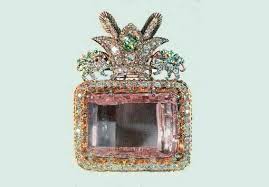In gem trade, when the
term pink diamonds is mentioned it immediately makes one think of Australian
mines producing one of the most rare color of diamonds- pink! But, history has
witnessed that one of the most exquisite pink gem ever unearthed came from the
mines of India in Andhra Pradesh. This legendary diamond is known as the
Darya-I-Noor.
The Jewel Affair attempts
to put forward the story of this renowned gem,The Darya-I-Noor which literally means the sea of light!
The Darya-I-Noor is the
largest ever naturally pink color diamond which was discovered in the Golconda
mines in Andhra Pradesh (India). The first ever account of this stone was given
by Jean-Baptiste Tavernier in his book Travels in India in the year 1642.
Darya-I-Noor has been referred to as the Great Table Diamond and the estimated
weight suggested is 242 cts. After this
account there was no mention of this stone anywhere, it seemed to have disappeared.
There are few suppositions as to what happened to this fabled diamond.
According to a speculation the stone first belonged the first Mughal emperor of
India and it eventually it came to Nadir Shah in the year 1739 when the Mughal
empire was invaded. In the battle of Karnal, Nadir Shah easily defeated
Mohammed Ali Shah and captured the capital. Famous jewels like Koh-I-Noor, the
Darya-I-Noor and the Peacock Throne were surrendered by Mohammed Ali Shah, to
Nadir Shah and gradually these gems and jewels found their way to Iran.
 |
| THE DARYA-I-NOOR |
Couple of years later when
Nadir Shah died, the gem passed on to his grandson and changed hands with many
other owners including the Zend Dynasty.The stone in this period was observed
by Sir Harford Jones Brydges, who was the envoy in the court of the Zend
dynasty. The stone was sold to raise money for war against the The Dynasty of
Kajars. He observed that it was a pale pink, huge table diamond which matched
the findings of Tavernier. It was a speculation that Darya-I-Noor and the Great
Table was one and the same. The only discrepancy was in terms of weight.
According to Brydges it weighed approximately 176 carats.
Finally the war was won by
the Kajars and the spectacular gem was taken over by them and in the year 1834,
Fath Ali Shah had his name inscribed on the gem. Later the gem was acquired by
Pahalvi Dynasty and was worn by Reza Shah in his coronation military hat. The
stone was seen again in the year 1967 on a special occasion where gemologists
from Canada were invited to study and certify the Crown Jewels of Iran. When
the gemologists took a closer look at the Darya-I-Noor, they found that the
stone had striking resemblance with the The Great Table. The only matter of
concern was the weight. Later they arrived at a conclusion that may be the
stone met with an accident and split into two pieces. Their assumptions found a
ground when they discovered another pink diamond in the Iranian Crown Jewels,
Noor-ul-Ain which weighs nearly 60 carats and exactly matches the color of the
gem. The Noor-ul-Ain was set as a centerpiece in a tiara made by Harry Winston,
for the wedding of the Empress of Iran, Farah Diba for her wedding.
 |
| NOOR-UL-AIN |
 |
| EMPRESS FARAH DIBA |
However when the weight of
both the stones was put together it surpassed that of the Great Table. The
gemologists started working to put this puzzle together and later arrived at a
supposition that Tavernier’s findings were incorrect.
This stunning gem has had
an extremely mysterious past but its beauty never fails to baffle the onlooker. It not only has been a pride of the royalties
but also been an example of classic and timeless splendor.
